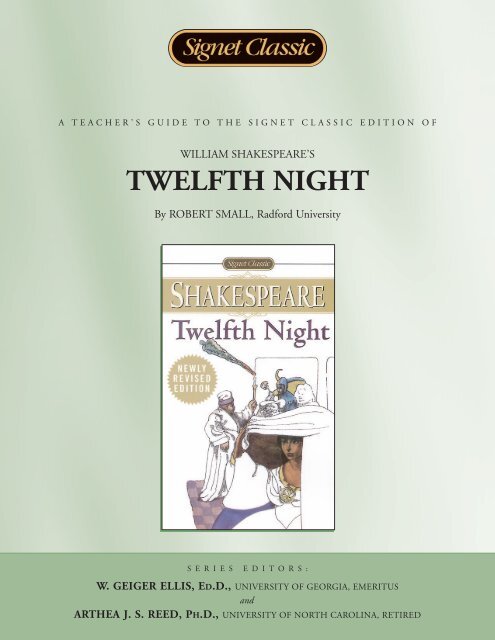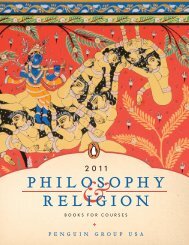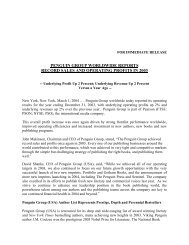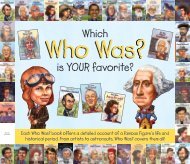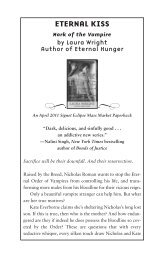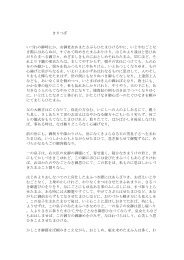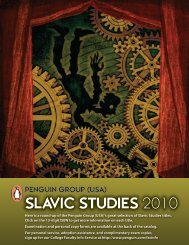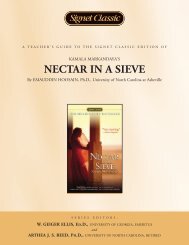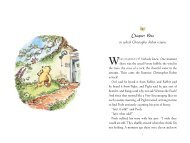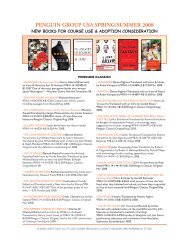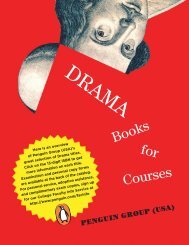Twelfth Night TG - Penguin Group
Twelfth Night TG - Penguin Group
Twelfth Night TG - Penguin Group
You also want an ePaper? Increase the reach of your titles
YUMPU automatically turns print PDFs into web optimized ePapers that Google loves.
A TEACHER’S GUIDE TO THE SIGNET CLASSIC EDITION OF<br />
WILLIAM SHAKESPEARE’S<br />
TWELFTH NIGHT<br />
By ROBERT SMALL, Radford University<br />
SERIES EDITORS:<br />
W. GEIGER ELLIS, ED.D., UNIVERSITY OF GEORGIA, EMERITUS<br />
and<br />
ARTHEA J. S. REED, PH.D., UNIVERSITY OF NORTH CAROLINA, RETIRED
A Teacher’s Guide to the Signet Classic Edition of William Shakespeare’s <strong>Twelfth</strong> <strong>Night</strong> 2<br />
INTRODUCTION<br />
<strong>Twelfth</strong> <strong>Night</strong> or What You Will is an interesting blend of the sadness of separation between brother and sister, romance as<br />
each of them falls in love, farcical comedy filled with mostly gentle sarcasm and irony, and a bang-up happy ending for<br />
the brother and sister, re-united and also now loved by the one each loves. In between there is the intriguing complexity<br />
of mistaken identities, plots to fool foolish characters, and a couple of pompous characters who get what they deserve.<br />
Thus, although some of the conventions of Shakespeare’s time give the play a twist different from a similar comedy of our<br />
own time, there is much in the play that resembles a light and entertaining movie or television special. Handled in this<br />
way rather than as an icon to be paid homage to, <strong>Twelfth</strong> <strong>Night</strong> has much in it to appeal to the sentimental, the silly, and<br />
the critical in most modern high school students. And, of course, there is the character of Malvolio, exactly the type of<br />
pompous prig that teenagers especially seem to love to see put down by those he has picked on and preached to.<br />
As the play progresses, one can almost hear teenagers yelling, “But he’s a she! Can’t you tell, you fool!” It is equally easy<br />
to hear them warning Sebastian and cheering when Sir Andrew and Sir Toby and especially Malvolio get their just desserts<br />
and as the mix-up of brother and sister and who’s in love with whom is straightened out at the end. And throughout,<br />
these teenage readers laughing, jeering, sighing at romantic spots perhaps, expressing enjoyable disbelief that anything so<br />
mixed up could ever really happen or—if it did, be straightened out so conveniently in five acts—will be reacting to the<br />
play as its original audiences did.<br />
The title of the play seems to refer to the last twelve days of Christmas, as in the song we hear so often during that holiday<br />
period. The last day—or twelfth night—was in Shakespeare’s time a day of celebration and foolishness. The subtitle, What<br />
You Will, sounds suspiciously like the currently popular “whatever” used to say more or less, “I don’t care”; or, as has been<br />
suggested, when asked for a title, Shakespeare may have said “ <strong>Twelfth</strong> <strong>Night</strong> or call it what you will.” If this is the case—<br />
and there are other, more complex interpretations—then perhaps Shakespeare is saying to us and to our students, “Well,<br />
here it is in all its sentimentality, foolishness, lack of realism, insight into the folly of humankind or whatever you want<br />
to make of it.” If he is indeed giving us that freedom, then we and our students can sit back, laugh, make fun of characters,<br />
and see them as just like so and so—perhaps a teacher who is just like Malvolio—and make of it what we will.<br />
What follows in this guide is a look at the play act by act. (For a more idiosyncratic yet lively reading of the play, try<br />
O’Brien’s Teaching Shakespeare, pp. 26-28.) After the summary, the guide makes suggestions for ways to get students ready<br />
for reading the play, a few activities designed not to interfere with the natural flow of the events but to involve students<br />
more fully in those events and with the characters, and a couple of activities that can help students think about what they<br />
just saw and read and go on from there to take some stabs at creating from the raw material the play has given them.<br />
OVERVIEW<br />
IDENTIFICATION OF CHARACTERS<br />
Orsino, Duke of Illyria: Loves Olivia; loved by Viola; groom-to-be of Viola (at the end of the play)<br />
Lady Olivia: A rich countess; loved one of the Duke; loves Viola (as Cesario); bride-to-be of Sebastian (at the end of the play)<br />
Viola: Twin sister of Sebastian; Cesario; page to Lady Olivia; loves the Duke; bride-to-be of the Duke (at the end of the play)<br />
Sebastian: Twin brother of Viola; Roderigo; one who is confused with his twin sister (as Cesario); groom-to-be of Olivia<br />
(at the end of the play)<br />
Sir Toby Belch: Olivia’s uncle; a drunkard; co-conspirator with Sir Andrew, Feste, and Maria<br />
Sir Andrew Auguecheek: Suitor for Olivia’s hand in marriage; a foolish man; co-conspirator with Sir Toby, Maria, and Feste<br />
Feste: Clown; co-conspirator with Sir Toby, Sir Andrew, and Maria; occasional commentator on what is happening<br />
Malvolio: Olivia’s steward (Manager of Estate); a vain and pompous man; object of the conspiracy to humiliate him<br />
Maria: Servant of Olivia; co-conspirator with Sir Toby, Sir Andrew, and Feste<br />
Antonio: Sea captain; friend to Sebastian; old enemy of the Duke
A Teacher’s Guide to the Signet Classic Edition of William Shakespeare’s <strong>Twelfth</strong> <strong>Night</strong> 3<br />
Sea Captain: Friend of Viola<br />
Valentine and Curio: Aristocrats in Olivia’s court<br />
Fabian: An aristocrat in the Duke’s court<br />
SUMMARY<br />
ACT I, SCENE I<br />
The play begins with what is one of its two most familiar passages (the other being Malvolio’s sense of himself in Act II,<br />
Scene v), as the Duke of Illyria, Orsino, pining for the love of the Countess Olivia, says:<br />
If music be the food of love, play on!<br />
Give me excess of it, that, surfeiting,<br />
The appetite may sicken, and so die.<br />
That strain again! It had a dying fall.<br />
O, it came o’er my ear like the sweet sound<br />
That breathes upon a bank of violets,<br />
Stealing and giving odour. Enough! No more!<br />
‘Tis not so sweet now as it was before.<br />
O spirit of love, how quick and fresh art thou,<br />
That, notwithstanding thy capacity<br />
Receiveth as the sea, nought enters there,<br />
Of what validity and pitch soe’er,<br />
But falls into abatement and low price<br />
Even in a minute! So full of shapes is fancy<br />
That it alone is high fantastical.<br />
As he finishes that lament, the gentleman Valentine enters to tell him that Olivia thinks only of her dead brother and no<br />
one else.<br />
ACT I, SCENE II<br />
On the seacoast Viola has confirmation that she also has lost a brother, her twin Sebastian. Now in Illyria, she learns from<br />
a sea captain that the Duke Orsino is the ruler of the country and—an important piece of information dropped into the<br />
conversation—that he is a bachelor who loves Olivia. Viola decides that she wants to serve as a page to the Countess.<br />
When the captain makes it clear that Olivia is in seclusion, Viola decides to disguise herself as a man and seek to serve as<br />
a page in Orsino’s court.<br />
ACT I, SCENE III<br />
The action shifts to Olivia’s home, where we meet her uncle<br />
Sir Toby Belch, his friend Sir Andrew Aguecheek, and the Maria, a servant to Olivia. Sir Andrew, we will learn, considers<br />
himself a possible suitor for Olivia. In the foolishness that follows, Sir Toby persuades Sir Andrew to continue seeking the<br />
hand of Olivia, and each of them in slightly different ways show that they mostly love parties and festivities.<br />
ACT I, SCENE IV<br />
Having introduced us to most of the main characters directly or through references in the conversation, the play moves<br />
quickly ahead, as Viola enters, now dressed as a page and using the name Cesario. Viola as Cesario has become a favorite<br />
of the Duke Orsino. Still in love with Olivia, the Duke sends Viola on a mission to Olivia to tell her of his love. Speaking<br />
to herself, Viola reveals that she has fallen love with the Duke.
A Teacher’s Guide to the Signet Classic Edition of William Shakespeare’s <strong>Twelfth</strong> <strong>Night</strong> 4<br />
ACT I, SCENE V<br />
Back at Olivia’s we meet Feste, the Clown, who will, from time to time, comment ironically on the characters and action;<br />
and Malvolio, the head of Olivia’s household and a pompous ass, appears with the Countess. Sir Toby, now drunk,<br />
wanders in. At this point, Olivia gives in to Cesario’s (Viola’s) messages that he/she must see her. After Viola unsuccessfully<br />
represents Orsino’s love and leaves, the Countess discovers that she is falling in love with—not the Duke—but Viola as<br />
Cesario and sends Malvolio to carry a ring to Viola and ask her to return the next day.<br />
ACT II, SCENE I<br />
Back on the sea coast, Viola’s twin brother, Sebastian, who has re-named himself Roderigo, considers himself cursed to<br />
suffer more bad luck, and sets off for Orsino’s court with Antonio, a sea captain.<br />
ACT II, SCENE II<br />
On a street somewhere, Malvolio catches up with Viola, still disguised as a page, and delivers the ring, saying it must be<br />
hers left behind. After denying she left the ring, Viola realizes that the Countess is in love with her. The scene ends with<br />
Viola’s version of the play’s subtitle, “What You Will”: “O time! Thou must untangle this, not I./ It is too hard a knot for<br />
me t’untie!”<br />
ACT II, SCENE III<br />
Back at Olivia’s, Sir Toby, Sir Andrew, and Feste wander in after midnight still deep in partying. Feste sings one of<br />
Shakespeare’s most famous songs, “O mistress mine, where are you roaming?” and the others laugh and make friendly fun<br />
of his singing. Maria joins them, and then Malvolio shows up to tell them off for their drunken loudness. When he stalks<br />
out, the three plan revenge by forging a letter from Olivia that Malvolio will find and, thinking he is the subject of the<br />
letter, believe that Olivia’s letter is about him and she’s in love with him.<br />
ACT II, SCENE IV<br />
Back at the Duke’s, Viola delivers the rejection from Olivia to the Duke. The two discuss love, its pain and joy; and Viola<br />
shares her own sadness, pretending it is the story of her sister. The scene ends, with the Duke sending Viola back to Olivia<br />
with a jewel and a new message of love.<br />
ACT II, SCENE V<br />
Having given the plot against Malvolio a chance to develop, Maria drops the forged letter in Olivia’s garden, where<br />
Malvolio is bound to find it. Malvolio then enters and, as Sir Toby and Sir Andrew listen, talks of how things would be<br />
if he married Olivia, whom, we discover, he already suspects is in love with him. He finds the letter and reads it aloud.<br />
Completely taken in, he leaves, having resolved to smile and smile as the forged letter suggests he should and dress in a<br />
fashion the letter praises but, in fact, Olivia dislikes. The letter contains the famous passage, “some are born great, some<br />
achieve greatness, and some have greatness thrust upon ‘em,” which Malvolio will quote to Olivia shortly.<br />
ACT III, SCENE I<br />
The scene begins with an exchange between Viola, still masquerading as Cesario, and the Clown, that contains mostly<br />
joking but ends with a thoughtful passage by Viola about the Clown’s insight into the people he mocks. Olivia joins them<br />
in the garden; and, when they are alone, Cesario attempts again to represent the Duke to Olivia. Olivia, however, tells<br />
Cesario that she has fallen in love with him, not the Duke. Still pretending to be Cesario, Viola tells her that “no woman<br />
has; nor never none/Shall mistress be of it, save I alone,” a statement with strong double meaning.
A Teacher’s Guide to the Signet Classic Edition of William Shakespeare’s <strong>Twelfth</strong> <strong>Night</strong> 5<br />
ACT III, SCENE II<br />
Sir Toby and Fabian convince Sir Andrew, who still sees himself as a suitor for Olivia, to challenge Cesario to a duel. Maria<br />
joins them to let them know that the plot against Malvolio is working: he’s dressed himself as they suggested, in what they<br />
know—but he doesn’t—are clothes Olivia detests.<br />
ACT III, SCENE III<br />
Sebastian and the sea captain Antonio discuss Sebastian’s problems, and the sea captain gives him money for a room. They<br />
plan to meet later, and one might guess that brother and sister will soon be mixed up by the others.<br />
ACT III, SCENE IV<br />
This scene rapidly moves ahead the several mistaken understandings that keep us wondering how and when it’s all going<br />
to work itself out. Malvolio, now completely dressed in the clothes Olivia hates and acting with words and gestures that<br />
we know will offend her, speaks to her of the love he thinks she has for him.<br />
Olivia, knowing nothing of the phony letter, thinks he has lost his mind. Then Olivia learns that Cesario is back and<br />
leaves, and Malvolio lets us know that he thinks he’s done a great job of winning her and also leaves.<br />
In come Sir Toby, Fabian, and Maria to move along the other plot, Sir Andrew’s challenge of Cesario to a duel. When Sir<br />
Toby reads the letter challenging Cesario, he refuses to deliver it as too stupid to be believed, but, getting a chance to talk<br />
with the page, warns him that Sir Andrew is a bad guy and then warns Sir Andrew that Cesario is really tough. They then<br />
taunt Cesario and Sir Andrew, and the duel starts. But, as one might expect, it doesn’t progress very far before something<br />
stops it: Antonio, the sea captain and friend of Sebastian, wanders in, thinks Cesario (Viola) is Sebastian and challenges<br />
Sir Andrew himself. That duel doesn’t go very far either, because a couple of cops come in, recognize Antonio as an old<br />
enemy of the Duke, and arrest him. Naturally, Antonio asks Cesario for his money back. Cesario doesn’t have a clue what<br />
he’s talking about—but Antonio mentions rescuing “Sebastian” as he pleads for Cesario to do what is right and give him<br />
the money. That gives Cesario hope that his (her) brother lives.<br />
ACT IV, SCENE I<br />
The Clown runs into Sebastian on the street and, thinking he is Cesario, tries to get him to go back to Olivia. Sebastian,<br />
not knowing what the Clown is talking about, gives him some money to go away. Just then Sir Andrew, Sir Toby, and<br />
Fabian wander in, think Sebastian is Cesario, and attack him. Sebastian proves to be a much stronger fighter than Cesario;<br />
but Olivia also comes by, stops the fight, and takes Sebastian away with her.<br />
ACT IV, SCENE II<br />
Malvolio, thought to be mad by Olivia, has been locked up in a dark room. With the help of Sir Toby and Maria, the<br />
Clown, disguised as the parson, Sir Topas, makes fun of Malvolio.<br />
ACT IV, SCENE III<br />
In the garden, Sebastian worries about Antonio, who didn’t meet him as planned, and wonders about Olivia’s love for<br />
him. She, of course, still thinks he is Cesario. Olivia then enters with a priest, and she and Sebastian go into her chapel<br />
to be married.<br />
ACT V, SCENE I<br />
This act has only one scene, but what a scene it is! Starting with Fabian and the Clown, each of the characters enter in<br />
front of Olivia’s home. Duke Orsino arrives with his page Cesario (Viola) to try once more to win Olivia. The cops bring<br />
in Antonio, who speaks angrily of Sebastian’s lack of gratitude, thinking that Cesario (Viola) is Sebastian. Then Olivia<br />
appears and tells the group that she and Cesario (Viola) are married since she still believes that Sebastian is Cesario.<br />
Cesario (Viola) clearly doesn’t understand and claims that he (she) isn’t married to Olivia; but the angry Duke rebukes
A Teacher’s Guide to the Signet Classic Edition of William Shakespeare’s <strong>Twelfth</strong> <strong>Night</strong> 6<br />
him (her) and fires him. At this crucial moment, Sir Andrew and Sir Toby arrive to complain that Sebastian has attacked<br />
them and hurt them. Sebastian comes in right behind them, wanting to apologize to Olivia for hurting her uncle. And<br />
there they are, the twins. All is resolved when Olivia decides she is happy with Sebastian as her husband and Duke Orsino<br />
realizes that he is in love with Viola, formerly Cesario. The clown brings a letter from Malvolio that begins to reveal the<br />
plot that has landed him in the dark room, and the Duke and Olivia have him brought before them. Malvolio has kept<br />
the letter he thinks was from Olivia and hands it to her. Then all is revealed as Fabian and the Clown confess. Malvolio<br />
rushes out vowing revenge; the Duke sends the rest after him to try to talk out his anger. The Clown, left alone, ends the<br />
play with a slightly cynical song.<br />
TEACHING THE PLAY<br />
<strong>Twelfth</strong> <strong>Night</strong>, like Shakespeare’s other plays, is usually treated with a kind of reverence, much like standing in a gallery<br />
and looking in awe at a statue—looking with awe but with no other feelings. Wade and Sheppard in their study, “How<br />
Teachers Teach Shakespeare,” make the point that “it is futile for teachers to impose their own experiences upon students,<br />
because, at best, responses will be uniform and diluted. Establishment of a personal relationship with the text must be the<br />
first step, and students’ own responses and interpretations must be considered valid and worthwhile” (p. 23). They go on<br />
to conclude that “first-hand, dramatic experience leads to personal response and...exploration of a text through<br />
performance is an enjoyable way of illuminating communication between Shakespeare the playwright and his audiences”<br />
(p. 23). After an analysis of what a group of teachers indicated on a questionnaire, they conclude, “Despite recent changes,<br />
our findings are that for this sample of English teachers the most popular teaching methods remain the traditional and<br />
transmissional ones. The danger is that an elitist, high-culture, purely literary model of Shakespeare is presented through<br />
play-reading, literary critical analysis and scene summarizing” (p. 27).<br />
Yet Shakespeare meant <strong>Twelfth</strong> <strong>Night</strong> to be a romance that is funny in itself because of the many mistaken identities: Olivia<br />
falls in love with Viola, thinking she’s Cesario, and then marries Sebastian, who has been using the name Roderigo,<br />
because she thinks he is his twin Viola disguised as Cesario. And Cesario (Viola) has fallen in love with the Duke but, of<br />
course, being disguised as a man, can’t admit her love. All this confusion and mistakes makes us feel superior to these<br />
dense characters and, so, we laugh at them. The play is meant to be a true comedy as defined by incongruity; that is, a<br />
character like Malvolio, so full of self love, falls into the humiliation of being duped and treated as insane, exactly the<br />
opposite of the lofty state he sees for himself.<br />
Consequently, students should come to the play seeing it as a comedy where they laugh at the silly behavior of some<br />
characters with sympathy, like the Duke and Olivia, and others with none, like Malvolio and, to a lesser extent, Sir Toby<br />
and Sir Andrew. As suggested earlier, if they can see the play as a modern mixed-up, slightly crazy movie in Elizabethan<br />
dress, the play is likely to succeed with them.<br />
BEFORE READING THE PLAY<br />
The following activities should help students get into the mood for the play by looking at the plays they enjoy on<br />
television and in movies. Since the play was meant to be seen, not read and studied, looking at it as the script for a TV<br />
romantic comedy and trying to figure out how it might be adapted to TV will probably make sense to many students. So,<br />
adapting it — and that could mean cutting out some of the slower moving scenes — is an approach that can involve and<br />
intrigue students in a creative way.<br />
These activities should also prepare students to make connections between the various sources of humor in <strong>Twelfth</strong> <strong>Night</strong>,<br />
the light romantic humor and the more sarcastic humor, and the television shows they laugh at every day. The activities<br />
also might help them look at their world, if not critically, at least more objectively.<br />
1. Ask students to take notes on an episode of their favorite TV comedy, marking especially places where they—and their<br />
friends, if they were watching it in company—laughed a lot. In class in small groups, ask them to make a list of especially<br />
funny parts and then try to figure out why they were laughing. Have the groups share the funniest episodes and the<br />
reasons why they thought they were funny. Look at the results and ask, “So what makes something funny?” As there is<br />
surely no one right answer, anything from the sentimental to the cruel should be allowed to stand. One question that<br />
should be explored is, “Can you care about people you’re laughing at?”<br />
2. Ask students, “What causes people to fall in love?” Suggest that they think about people they know, characters in TV<br />
programs, movies, and stories as well as their own experiences—if they want to include the personal—and try to write<br />
down at least three different reasons why people fall in love. Then have them make a list of the reasons for falling in love
A Teacher’s Guide to the Signet Classic Edition of William Shakespeare’s <strong>Twelfth</strong> <strong>Night</strong> 7<br />
and put the most frequently mentioned each on a sheet of paper and post the sheets around the room. Next ask the<br />
students individually to put a number on how long it took in each of the cases for the people involved to fall in love and<br />
put those numbers on the sheet under the appropriate cause. Then ask, “How long does it take to fall in love?” Again,<br />
there’s no right answer, of course.<br />
At this point, give students copies of the Duke’s first commentary on love—”If music be the food of love, play on” etc.<br />
(p. 3), perhaps written out as an essay rather than laid out on the page as a poem, and ask them what they think of it as<br />
something someone wrote when asked about LOVE. Corny? Well, that may not be too far from the reactions of some<br />
members of the audience and who knows what the Bard meant it to be.<br />
3. If students can handle the question, ask them to consider why people make fun of other people? Have some examples—<br />
the comic strips are a good source as are incidents you’ve heard in school or that have happened to friends—in hand. Then<br />
ask them to write a scene in which someone makes fun of someone else in an especially nasty way. Share the results. Then<br />
ask them to consider the emotions of the person on the receiving end and ask, “When is it OK to make fun of someone<br />
else?” and “How far is it OK to go?”<br />
4. If these activities are too analytic for the students who are about to study <strong>Twelfth</strong> <strong>Night</strong>, follow up Activity One by playing<br />
in class one of the funny episodes identified by a number of students and asking them, “Well, what did you think? Was<br />
it funny? If you thought so, why?”<br />
5. <strong>Twelfth</strong> <strong>Night</strong> follows a fairly conventional pattern in effect for drama in Shakespeare’s time and for several centuries<br />
thereafter. It has five acts and a number of scenes in each act. The characters are introduced at the beginning of the play,<br />
and the comic action begins. Through the next couple of acts the comic action becomes more involved (similar to the<br />
rising action of a tragedy), and then in the last act all the mess that has been created earlier is suddenly worked out. There<br />
are also commentaries by an observer (here Feste), misunderstandings that led to conflict, and so forth. Again, students<br />
can prepare themselves for dealing with these conventions by looking at the romantic comedies they watch on TV or in<br />
the movies. And, again, the conventions of plays like <strong>Twelfth</strong> <strong>Night</strong> are remarkably similar to the conventions of those TV<br />
programs and movies. To prepare students for reading the play, a look at how TV sitcoms are structured can give them a<br />
pattern that will be familiar to follow.<br />
6. The text of the play contains a “Cast of Characters,” as do most popular TV programs and movies. A discussion of each of<br />
the characters with a limited amount of information about each provided in contemporary terms by the teacher may be<br />
helpful. For example, the Duke of Illira is a really rich guy who wants to fall in love and has picked a woman who doesn’t care<br />
for him or want to fall in love with anyone. So, who might play the part? The eventual cast (or casts) of actors from the popular<br />
media might be blown up to poster size and mounted on a board for future reference. Changes in casting aren’t unusual<br />
in TV or the movies, and they certainly should be made as the producers (students) move through the production.<br />
WHILE READING THE PLAY<br />
The activities suggested during the reading of the play are intended to be carried out as preliminary to decisions about how<br />
the play might be dealt with as a modern movie or TV romantic comedy. Therefore, for example, students who are speaking<br />
lines from the play or carrying out the actions of characters should see what they are doing as if deciding what’s being said and<br />
done and how it fits into the idea of a modern counterpart, rather than trying to become trained Shakespearean actors.<br />
1. Consider the title. What can twelfth night mean? Many, perhaps most, students won’t know about the Feast of the Epiphany,<br />
but they certainly will have heard the song “The Twelve Days of Christmas.” Knowing that <strong>Twelfth</strong> <strong>Night</strong> is the last of the<br />
days of the song probably won’t help them much, so they’ll have to be told that in earlier times twelfth night was a time<br />
of wild celebration. Comparing it to Mardi Gras should help.<br />
The subtitle What You Will has provoked much speculation. Ask students to consider when they might say, “What you will.”<br />
One possible meaning is similar to the currently popular “whatever,” which seems to mean “I don’t care” or “it doesn’t<br />
matter,” that is, a kind of dismissal.<br />
Scholars have suggested that it is tied to the concept of the will as in willpower, willful, willing, etc. Ask students to look<br />
for as many words as possible that contain the prefix “will.” From their list, ask them to think about the various meanings<br />
of “will” and hold those meanings in mind as they read the play.<br />
2. As is suggested in a number of the works in the Bibliography, a play is a play; that is, a play is meant to be performed, its words<br />
meant to be spoken, not read silently. Gibson, in his excellent book Teaching Shakespeare, points out, “Shakespeare was<br />
essentially a man of theatre who intended his words to be spoken and acted out on stage. It is in that context of dramatic
A Teacher’s Guide to the Signet Classic Edition of William Shakespeare’s <strong>Twelfth</strong> <strong>Night</strong> 8<br />
realisation that the plays are most appropriately understood and experienced. The consequence for teaching is clear: treat the<br />
plays as plays, for imaginative enactment in all kinds of ways” (p. xii). Consequently, producing the play should be the goal<br />
of the class activities. Students should consider each scene in terms of how it should be spoken and what physical actions<br />
should accompany it. To determine how the lines should be delivered, students should consider what tones and actions<br />
they might use if they were saying a modern version of the words: loud, quiet, angry, loving, upset, shocked, etc. They<br />
should attempt to use those same intonations when reading Shakespeare’s lines. These activities can be done in pairs or<br />
small groups. Students should never be asked to read passages that they have not had the opportunity to prepare.<br />
3. Expecting students both to speak lines and carry out the physical actions that go with them is often to expect too much.<br />
One technique that has been successful in producing a play is to give each role to two students, one to speak the lines and<br />
the other to perform the actions of the character. Scenes that would work well for this approach might be:<br />
Act I: scene iii, scene iv, scene v<br />
Act II: scene iii, scene v<br />
Act III: scene iv<br />
Act V: scene i.<br />
4. The events of the play, while not earth-shattering or tragic, are fairly complex. Directors of TV programs and movies have<br />
chronologies that track the action of what they are directing. One group of students might be asked to serve as recorders<br />
of the action. As the play progresses, they are responsible for recording what has happened — somewhat as the “Overview”<br />
earlier in the guide has done. At the start of each day’s rehearsal, they review the action of the previous day, as they might<br />
for the cast and support staff for a TV show. Then the next act/scene is rehearsed.<br />
5. Characters are very important in all drama, and the characters of <strong>Twelfth</strong> <strong>Night</strong> make the play by their foolish actions, the<br />
love they feel for each other, their romantic dreams, and their relations to each other. One way a director can track the<br />
episodes of the play is to assign one or more staff members to teams to record what a single character said and did and a<br />
description of that character’s mood, feelings, relations to other characters. These reports can be shared with the entire<br />
class each day as they would be with the cast and support staff of a production.<br />
6. The names of the characters in the play carry a great deal of meaning. Students can consider the following question: What<br />
would you think of a person named like these?<br />
Sir Toby Belch — perhaps vulgar, disgusting<br />
Sir Andrew Aguecheek — after looking up “ague” perhaps weak, sickly, twitchy<br />
Malvolio — with a bit of help with “volio” perhaps someone who wishes evil or finds evil because he wishes to<br />
Feste — perhaps festive, causing a festival, lively and ready for a party.<br />
Then students can look for similarly suitable names for the other characters: Sebastian = Braveheart, or Olivia = Aloofisha.<br />
They can surely find better examples. Then they can examine names in the TV programs they’ve been using as reference<br />
points and see if any of the names fit the characters in the same way.<br />
7. To help students visualize the characters, once they have been introduced by the end of Act I, they can look for magazine<br />
pictures that seem close to representing each of the characters as they see them. The collection of pictures of each character<br />
can be gathered together and secured to large sheets of paper. As the reading of the play and consideration of similar<br />
modern drama continues, students can refer to the pictures to help them see the characters as if they were in a TV comedy.<br />
8. Although individual in many ways, the characters in <strong>Twelfth</strong> <strong>Night</strong> are also stock characters. As students observe more<br />
about each character in action, they might try to categorize the characters by reference to characters of the same type in<br />
modern plays. Sir Toby, for example, fits into the category of a slapstick character; the Duke, a lovesick dolt. Examining<br />
how modern versions of these character types are portrayed will, of course, help both in staging the play and in considering<br />
what modern version it might be like.<br />
9. Shakespeare’s language, though wonderful, is a problem for modern young readers. As a part of the production of a TV<br />
show or movie, a task force can be assigned the responsibility of watching for words and expressions that might not be<br />
familiar to the audience. A group of students — especially those interested in language — can be assigned the role of<br />
“Language Watchdogs” to catch such words and expressions, decide how crucial the understanding of them is to the<br />
audience, and suggest alternatives. The task force might also propose replacements, and the class can decide which<br />
replacements would still work in the overall language of the play.
A Teacher’s Guide to the Signet Classic Edition of William Shakespeare’s <strong>Twelfth</strong> <strong>Night</strong> 9<br />
10. There are several scenes in the play that are crucial to understanding and appreciation:<br />
Act I, scene iv — Viola revels that she, pretending to be a he, has fallen in love with Duke Orsino.<br />
Act I, scene v — Countess Olivia reveals that she has fallen in love with Cesario, really Viola.<br />
Act II, scene iii — The conspirators plan revenge on Malvolio after he reprimands them.<br />
Act II, scene v — Malvolio finds the forged letter and is taken in by it.<br />
Act III, scene iv — Malvolio makes a fool of himself before Olivia; Sir Andrew starts his duel; and Viola/Cesario,<br />
seen as Sebastian, refuses to return money to the sea captain, thus giving Viola hope that her brother lives.<br />
Act IV, scene iii — Olivia marries Sebastian, thinking he is Cesario/Viola<br />
Act V — The deceptions are discovered and the plot resolved.<br />
Students can identify the scenes they think are crucial and discuss why and what would have happened if that scene had<br />
never taken place. Since there are no “right” answers, the discussion can, at any time, be left on hold until the end of the<br />
play and then re-visited.<br />
AFTER READING THE PLAY<br />
Once students have finished reading, acting, and discussing the play to its concluding scene, they can look back at what<br />
has happened, as they might when leaving a movie theater. In some cases, a “So what did you think?” may be enough.<br />
The following activities, however, are designed to help them think about characters and plot, and especially comedy and<br />
romantic love.<br />
1. This guide has given an act-by-act, scene-by-scene overview of the play. With all the complexities of plot and character,<br />
summarizing <strong>Twelfth</strong> <strong>Night</strong> isn’t easy. Students can pretend that they’ve just seen it as a TV program or movie and a friend<br />
asks, “What was it about?” They can write what they would say — record it — without using acts and scenes since movies<br />
and TV rarely resort to such divisions. Then they can exchange papers with another student, each student trying to play<br />
the role of the friend who made the mistake of asking, “What’s it about?”<br />
2. Many people in the play are in love with almost none of that love being returned until the end of the play. Students can<br />
look back at each of those relationships and ask:<br />
• Was he really in love with her or did he just think he was?<br />
• How did he feel when he learned that she didn’t love him?<br />
• How did she feel knowing he loved her but she didn’t love him? And especially when she loved someone else who<br />
didn’t love her?<br />
(To keep the questions as simple as possible, the guide uses only one pronoun where “he/she” fits most of the references<br />
in the questions. Some of these questions will apply to more than one character and not all will apply to every character.<br />
Answering them, however, does force students to consider — perhaps reconsider — the different aspects of romantic love<br />
displayed in the play.)<br />
3. Since the approach suggested in this guide is to treat the play as an Elizabethan TV comedy, students can reflect on the various<br />
events of the play and create a plan to present it in a year or less as a TV series. What would the fall premier be? Would it<br />
start the way Shakespeare started his play? What would happen in each half-hour episode? What would the season finale be?<br />
4. Students can look back at the TV series and movies they considered before reading the play and look for ways that <strong>Twelfth</strong> <strong>Night</strong><br />
resembles one or more than one. They previously considered what makes a TV episode funny; now they can use the results<br />
of that consideration when discussing what makes <strong>Twelfth</strong> <strong>Night</strong> funny or at least, what funny elements are included.<br />
5. Working from a list of the significant characters, students can select the one they would like to play in a production of<br />
<strong>Twelfth</strong> <strong>Night</strong> and explain why by referring to events involving the character and the words the character speaks. As an<br />
alternative, they might choose the character they wouldn’t want to have to play.<br />
6. Students can vote for the silliest, wisest, meanest, and most likable character in the play (much like class yearbooks have Class<br />
Clown, Cutest Couple, etc.) and then discuss why they selected each, referring to specific actions and dialogue of the characters.
A Teacher’s Guide to the Signet Classic Edition of William Shakespeare’s <strong>Twelfth</strong> <strong>Night</strong> 10<br />
7. The character of Malvolio fascinates both scholars and actors. They argue that he is the perfect “pompous prig” and a<br />
character meant to be seen as getting what he deserves. They see Shakespeare as having created a character we can despise<br />
because of his undeserved high opinion of himself, be angry with for his domineering behavior toward others, and gain<br />
satisfaction from when the plot works to reveal all that is wrong with him. Others, however, have seen him as a<br />
sympathetic character, especially at the end of the play, when they believe he displays dignity in a very humiliating<br />
situation. Actors have often played him that way.<br />
Students can look closely at what Shakespeare has Malvolio do and say and try to come to their own conclusions. A useful<br />
source is the Adams and Gould book Into Shakespeare, listed in the Bibliography, as is Coursen’s Teaching Shakespeare with<br />
Film and Television: A Guide, which, in Chapter 7 focuses on Act IV, scene 2, in which Malvolio is locked in darkness<br />
because he is thought to be mad.<br />
8. Some scenes in the play are filled with action related to the development of the plot (Act III, Scene iv, for example), and other<br />
scenes seem less so (Act IV, Scene ii, for example). Some scenes merely introduce one important character (Act II, Scene 1,<br />
for example). Students can review Shakespeare’s approach to including introduction of characters, direct action, revelation<br />
of a fact important to the play, etc. and consider other ways in which he might have accomplished the same purpose.<br />
9. Many of the events of the play are difficult to impossible to believe could actually happen. Indeed, the term “willing suspension<br />
of disbelief” applies to what one must do to enjoy this play. Students can examine what they do when faced with stories, TV<br />
programs, or movies that intentionally include things that almost surely could never happen by considering the following:<br />
Sometimes writers or movie directors present situations and characters that you are supposed to understand are<br />
unbelievable yet with which you are supposed to go along for the fun or some other reason. How do you<br />
recognize when this is what is expected of you? When do you know that the writer or movie director thinks you<br />
will believe in something that only a dummy would? What is the difference?<br />
10. Shakespeare wrote a number of other comedies, of course; a few students might like to read one or more of them.<br />
Especially interesting after a study of <strong>Twelfth</strong> <strong>Night</strong> are Much Ado about Nothing, The Comedy of Errors, and As You Like It.<br />
11. There is much information, commentary, and other material about Shakespeare and his works on the internet. Students<br />
can form teams to explore different sources on the web related to Shakespeare and look for material that presents ideas<br />
about the relationship of his works to modern beliefs, culture, and entertainment. Carol Schuetz’s Shakespeare Goes Online<br />
is a good starting place.<br />
12. Peggy O’Brien’s Teaching Shakespeare (pp. 46-50), provides an interesting plan for studying characterization in <strong>Twelfth</strong><br />
<strong>Night</strong>. She poses questions such as “Is [Malvolio] the only character in love with himself?” and devotes considerable<br />
attention to the importance of masks, real and figurative, to the play.<br />
EXTENDED LEARNING<br />
Going beyond the conclusion of a work of literature allows for speculation and creativity that requires an understanding<br />
of what happened in the work, the characters as they were at the end, and how the characters changed during the work.<br />
Doing so is also a natural part of reading literature and responding to it. Readers typically ask themselves the simple<br />
sounding question, “I wonder what happens next,” as do people leaving a playhouse or movie theater.<br />
1. Continuing the idea of the play being the script for a season of a TV sitcom, students can develop the second season using<br />
many of the same characters, introducing new ones, following up on the final episode (act V of the play).<br />
2. Each student can select a character as he or she is at the end of the play and, using the situation existing then, speculate<br />
on what would happen the next day, the next week, or the next year in that person’s life. Of course, one cannot do that<br />
without a pretty good understanding of who the character is and what the situation surrounding him or her is at the end<br />
of the play. Who is Olivia now that she is married to Sebastian? What kind of revenge will Malvolio seek and on whom?<br />
Will Malvolio gain insights into himself from his humiliation?<br />
3. The English language is filled with expressions that are brief quotations from the works of Shakespeare. Many, perhaps<br />
most of us, don’t recognize them as coming from his plays and poems. Book titles, such as Faulkner’s Sound and Fury,<br />
taken from Shakespeare’s works are especially numerous. <strong>Twelfth</strong> <strong>Night</strong> contains several such phrases and proverbs, such<br />
as “cakes and ale,” “if music be the food of love, play on,” and the several times repeated, “some are born great, some<br />
achieve greatness, and some have greatness thrust [or “thrown,” as the Clown says at the end] upon them.” The latter,<br />
used for comedy in the play, is often quoted as a serious and insightful view of human achievement.
A Teacher’s Guide to the Signet Classic Edition of William Shakespeare’s <strong>Twelfth</strong> <strong>Night</strong> 11<br />
Students interested in language and language history can go beyond this play to research expressions that come from<br />
Shakespeare, reviewing both where in his works they appear, what they mean in context, and how they are used today.<br />
4. <strong>Twelfth</strong> <strong>Night</strong> is written in a version of the English language now 400 years old and by a poet-playwright drawing on an<br />
extraordinarily large and varied vocabulary reflecting common usage, legalisms, terms from medicine and warfare, and<br />
words and phrases from nearly every other aspect of Elizabethan life, culture, and society. It is no wonder that most<br />
modern readers and those attending performances of Shakespeare’s plays struggle with the play’s language. Likewise,<br />
conventions of drama employed by Shakespeare, the structure of the theaters in which his plays were performed, and<br />
many other factors keep the play from being as approachable as we would like it to be for students.<br />
Students who have studied <strong>Twelfth</strong> <strong>Night</strong> can extend both their understanding of the language of Shakespeare and the<br />
conventions, characters, and events of the play by attempting to rewrite the play using today’s language, society, and<br />
humor. Individual students can rewrite one act or several scenes from several acts, or a group of students can attempt a<br />
collaborative effort to rework the entire play. Those who have complained during class, “Why couldn’t he just say it in<br />
ordinary English?” can be challenged to put it into “ordinary English” within contemporary society.<br />
5. Comic love relationships are a common theme of many TV programs, movies, and contemporary literature, including<br />
works for young adults. Students can look at today’s media for events and characters that seem a lot like those in <strong>Twelfth</strong><br />
<strong>Night</strong> and prepare analyses of the similarities and differences of those characters.<br />
6. Some students might develop an interest in the theater of Shakespeare’s time. They can research how plays were delivered<br />
to the people of England at that time and compare that delivery system to today’s multi-media delivery of drama.<br />
7. Other students might wonder about comedy in Elizabethan times and want to look at other comedies by Shakespeare and<br />
by other authors of the time. They can try to determine what was funny then, what is funny now, and whether Elizabethan<br />
and contemporary theater have anything in common.<br />
BIBLIOGRAPHY<br />
CRITICAL EXAMINATIONS OF THE PLAY<br />
Billington, Michael. Approaches to <strong>Twelfth</strong> <strong>Night</strong>. London: Nick Hern, 1990. Gives the reader a look at production<br />
histories of the play by including interviews with a number of directors.<br />
Bloom, Harold, ed. William Shakespeare’s <strong>Twelfth</strong> <strong>Night</strong>. New York: Chelsea House Publishers, 1987. Bloom states in his<br />
introduction that “This book gathers together a representative selection of what I judge to be the best modern criticism<br />
upon Shakespeare’s <strong>Twelfth</strong> <strong>Night</strong>.” The essays range from a Marxist reading to a look at the role of music in the play.<br />
Cookson, Linda, and Bryan Loughery, eds. <strong>Twelfth</strong> <strong>Night</strong>. London: Longman, 1990. An interesting look at how the play<br />
might be produced.<br />
Coursen, H. R. Teaching Shakespeare with Film and Television: A Guide. Westport: Greenwood Press, 1997. This book is a<br />
key work for the approach suggested by this guide: the play as a TV program. Although it doesn’t overtly suggest that a play<br />
like <strong>Twelfth</strong> <strong>Night</strong> be seen as a TV comedy, it looks carefully at films and TV productions of Shakespeare’s plays as well as<br />
adaptations. Chapter 7 focuses on the scene in <strong>Twelfth</strong> <strong>Night</strong> in which Malvolio is confined because he is thought to be mad.<br />
Draper, John W. The <strong>Twelfth</strong> <strong>Night</strong> of Shakespeare’s Audience. New York: Octagon Books, 1975. Draper’s book contains chapters<br />
on the significant characters as well as on plot, characterization, setting, style, and theme, as well as background material.<br />
Folger Library. Shakespeare Set Free III: Teaching <strong>Twelfth</strong> <strong>Night</strong> and Othello. New York: Washington Square Press, 1995.<br />
The Folger Library has long made the case for teaching Shakespeare’s plays as lively, contemporary works that can speak<br />
to audiences of all ages. This volume looks at the two plays from that perspective.<br />
Hotson, Leslie. The First <strong>Night</strong> of <strong>Twelfth</strong> <strong>Night</strong>. New York: Macmillan, 1954. Using documents from the time, Hotson<br />
weaves a story leading up to and explaining the setting for the first production of the play.<br />
King, Walter N., ed. Twentieth Century Interpretations of <strong>Twelfth</strong> <strong>Night</strong>. Englewood Cliffs, N. J.: Prentice-Hall, 1968.<br />
Divided into two sections, “Interpretations” and “Viewpoints,” the articles cover topics from the mistakes made by the<br />
characters in the play to how those errors influence the themes and plots of the play.
A Teacher’s Guide to the Signet Classic Edition of William Shakespeare’s <strong>Twelfth</strong> <strong>Night</strong> 12<br />
Leech, Clifford. <strong>Twelfth</strong> <strong>Night</strong> and Shakespearean Comedy. Toronto: University of Toronto Press, 1968. In three lectures<br />
celebrating the 400th anniversary of Shakespeare’s birth, Leech traces the sources of the play, the play itself, and what<br />
followed in Shakespeare’s writing, particularly his writing of comedies.<br />
Palmer, D. J. ed. Shakespeare: <strong>Twelfth</strong> <strong>Night</strong>. London: Macmillan, 1972. This collection contains comments, some very<br />
brief and some slightly longer, on <strong>Twelfth</strong> <strong>Night</strong> from writers such as Samuel Johnson, Charles Lamb, and John Masefield.<br />
It also contains essays on the play, many of which also appear in the Walter King volume listed above.<br />
Wells, Stanley. <strong>Twelfth</strong> <strong>Night</strong>: Critical Essays. New York: Garland, 1986. A collection of essays on <strong>Twelfth</strong> <strong>Night</strong> by<br />
Shakespearean scholars and by literary luminaries such as Max Beerbohm and Virginia Woolf.<br />
Williams, Porter, Jr. “Mistakes in <strong>Twelfth</strong> <strong>Night</strong> and Their Resolution” in Palmer, D. J., ed., Shakespeare: <strong>Twelfth</strong> <strong>Night</strong>.<br />
London: Macmillan, 1972, pp. 170-187. Williams analyzes the mistakes made by the characters in the play both as<br />
devices to provoke laughter and also as revealing much about the characters themselves.<br />
Winter, William. Shakespeare on the Stage, second series. New York: Benjamin Bloom, 1969. In his classic work on<br />
Shakespeare’s plays, Winter begins his analyses with a detailed look at <strong>Twelfth</strong> <strong>Night</strong>.<br />
TEACHING THE PLAYS OF SHAKESPEARE<br />
Adams, Richard, ed. Teaching Shakespeare: Essays on Approaches to Shakespeare in Schools and Colleges. London: Robert<br />
Royce Limited, 1985. This collection of essays covers topics such as how to approach Shakespeare, staging a play, and<br />
publications that will be useful to the teacher.<br />
Adams, Richard, and Gerald Gould. Into Shakespeare: An Introduction to Shakespeare through Drama. London: Ward Lock<br />
Educational, 1977. Taking a particular approach to each of a number of Shakespeare’s plays, Adams and Gould illustrate<br />
how a production might deal with twelve of the plays. <strong>Twelfth</strong> <strong>Night</strong> (pp. 14-27) is approached through what the authors<br />
call the theme of “a pompous ass,” that is, the treatment of Malvolio. Both the illustrations and the detailed look at<br />
rehearsing for a production that focuses on the episodes in the play that deal with Malvolio make this book essential for<br />
the teaching of the play as a play.<br />
Davis, James. “’Pluck Out the Heart of the Mystery’: How to Bring Shakespeare to the Boondocks, and Other Places,”<br />
in James E. Davis, editor. Teaching Shakespeare. Focus: Teaching English in Southeastern Ohio. Athens, Ohio: The<br />
Southeastern Ohio Council of Teachers of English, May, 1976, pp. 2-6. Davis looks at ways to bring Shakespeare to<br />
students, especially through approaches to the playwright’s language.<br />
Davis, James E., editor. Teaching Shakespeare. Focus: Teaching English in Southeastern Ohio. Athens, Ohio: The<br />
Southeastern Ohio Council of Teachers of English, May, 1976. This issue of Focus contains a number of essays by teachers<br />
discussing how they have approached the teaching of Shakespeare’s plays.<br />
Davis, James E. and Ronald E. Salomone. Teaching Shakespeare Today: Practical Approaches and Productive Strategies.<br />
Urbana, IL: National Council of Teachers of English, 1993. Davis and Salomone have collected a number of essays that<br />
provide background on Shakespeare’s works, ways of using performance to approach the plays, and resources that are<br />
available to the teacher of the works such as films, recordings, and hypertext.<br />
Davis, Ken. Rehearsing the Audience: Ways to Develop Student Perceptions of Theatre. Urbana, IL: National Council of<br />
Teachers of English, 1988.<br />
Edens, Walter, et al, eds. Teaching Shakespeare. Princeton: Princeton University Press, 1977. Although aimed at the<br />
teaching of Shakespeare’s plays at the college level, the 14 essays in this volume provide insights into both the problems<br />
of and ways to succeed in teaching the plays. The essays are divided into five sections: “Descriptions and Prescriptions,”<br />
“Shakespeare and the English Curriculum,” “The Course in Shakespeare: Genre and Canon,” “Exemplary Approaches to<br />
Particular Plays,” and “Seeing and Hearing the Play.”<br />
Evans, Bertrand. Teaching Shakespeare in the High School. New York: Macmillan, 1966. Although over 30 years old, this<br />
text takes a thoughtful look at how to engage students with the works of the Bard. <strong>Twelfth</strong> <strong>Night</strong> is explored briefly in<br />
chapter eleven.<br />
Gibson, Rex. Teaching Shakespeare. Cambridge: Cambridge University Press, 1998. Gibson looks at the teaching of Shakespeare’s<br />
play from multiple perspectives, from “Why Teach Shakespeare?” through language, character, story, and for younger<br />
readers. There is considerable emphasis on producing the plays. <strong>Twelfth</strong> <strong>Night</strong> is considered frequently throughout the book.
A Teacher’s Guide to the Signet Classic Edition of William Shakespeare’s <strong>Twelfth</strong> <strong>Night</strong> 13<br />
Leach, Susan. Shakespeare in the Classroom: What’s the Matter. Philadelphia: Open University Press, 1992. Based in part on<br />
the Shakespeare in the Schools Project, this look at teaching Shakespeare’s works is designed, as the introduction says, to<br />
bring “Shakespeare to life for the present, to release it from a kind of embalmment that has often afflicted it in the past.”<br />
O’Brien, Peggy. “Shakespeare Is for Everyone,” Teaching Theatre, vol. 5, no. 1, pp. 10-12. O’Brien examines the status of<br />
teaching Shakespeare in schools and, taking the Folger Library’s approach that Shakespeare can be for all readers, suggests<br />
how teachers can bring students and the Bard together.<br />
O’Brien, Peggy. Teaching Shakespeare. London: Edward Arnold, 1982. After a look at how Shakespeare is usually approached<br />
in schools, O’Brien examines the principles governing the Folger’s program, including the belief that every student can<br />
enjoy the plays and that performance by students is the most effective approach. <strong>Twelfth</strong> <strong>Night</strong> is considered in chapters<br />
three and four.<br />
Robinson, Randal. Unlocking Shakespeare’s Language: Help for the Teacher and Student. Urbana, IL: National Council of<br />
Teachers of English and the ERIC Clearinghouse on Reading and Communication Skills, 1989. After a review of the<br />
problems that Shakespeare’s language presents today’s readers, Robinson provides detailed activities and materials to help<br />
students cope with that language.<br />
Rygiel, Mary Ann. Shakespeare among Schoolchildren. Urbana, IL: National Council of Teachers of English, 1992. Using<br />
four of the tragedies most often included in school literature programs, Rygiel discusses the background of the plays, the<br />
language of Shakespeare, and approaching the plays with students, including those of color.<br />
Salomone, Ronald Ernesto. Teaching Shakespeare II. Focus: Teaching English in Southeastern Ohio. Athens, OH: The<br />
Southeastern Ohio Council of Teachers of English, Fall 1985. In a follow-up to the popular earlier issue, Focus again looks<br />
at how teachers can approach Shakespeare’s plays with their students. Essays cover topics ranging from “Shakespeare<br />
Anxiety” to “Teaching Shakespeare to General Education Students.”<br />
Salomone, Ronald E. and James E. Davis, eds. Teaching Shakespeare into the Twenty-First Century. Athens: Ohio University<br />
Press, 1997. In a series of articles by teachers, the editors present successful ways of approaching Shakespeare. Particularly<br />
helpful are suggestions for the use of videos and computers to bring the plays to life for today’s students.<br />
Schuetz, Carol L. Shakespeare Goes Online: Web Resources for Teaching Shakespeare. ERIC No. ED420068, 1998. An<br />
annotated bibliography, this resource lists over sixty sources in five sections including one related to teaching Shakespeare<br />
and one dealing with specific plays.<br />
Wade, Barrie, and John Sheppard. “How Teachers Teach Shakespeare,” Educational Review, vol. 46, no. 1, pp. 21-28.<br />
Wade and Sheppard report on a survey they did of teachers in sec- ondary schools in Britain concerning teaching<br />
approaches to Shakespeare’s play. The most frequently used is what they call “traditional approaches”; the least widely used<br />
were performance of the plays and listening to recordings or viewing videos of the plays.<br />
ABOUT THE AUTHOR OF THIS GUIDE<br />
ROBERT SMALL is Dean of the College of Education and Human Development at Radford University in Southwest<br />
Virginia. He has served as chair of NCTE’s Assembly on Literature for Adolescents (ALAN) and as co-editor of its journal,<br />
The ALAN Review, as well as NCTE’s division on teacher education, the Conference on English Education. He also<br />
chaired the IRA Special Interest <strong>Group</strong> on Young Adult Literature (SIGNAL) and the IRA President’s Advisory<br />
Committee on Intellectual Freedom and is the author of a number of articles dealing with young adult literature and its<br />
place in the English Language Arts Curriculum.
ABOUT THE EDITORS OF THIS GUIDE<br />
W. GEIGER ELLIS, Professor Emeritus, University of Georgia, received his A.B. and M.Ed. degrees from the University of North Carolina<br />
(Chapel Hill) and his Ed.D. from the University of Virginia. His teaching focused on adolescent literature, having introduced the first<br />
courses on the subject at both the University of Virginia and the University of Georgia. He developed and edited The ALAN Review.<br />
ARTHEA (CHARLIE) REED, PH.D. is currently a long-term care specialist with Northwestern Mutual Financial Network and senior<br />
partner of Long-Term Care and Associates. From 1978 to 1996 she was a professor of education and chairperson of the Education<br />
Department at the University of North Carolina at Asheville. She is the author or co-author of 15 books in the fields of adolescent<br />
literature, foundations of education, and methods of teaching. She was the editor of The ALAN Review for six years and president of the<br />
Assembly on Literature for Adolescents of the National Council of Teachers of English (ALAN). She is currently co-authoring the 5th<br />
edition of A Guide to Observation, Participation, and Reflection in the Classroom (McGraw-Hill 2004). She has taught almost every grade<br />
from second grade through doctoral candidates. She lives in Asheville, North Carolina with her husband Don, two dogs, and a cat.<br />
FREE TEACHER’S GUIDES<br />
A full list of Teacher’s Guides and Teacher’s Guides for the Signet Classic Shakespeare Series<br />
is available on <strong>Penguin</strong>’s website at:<br />
www.penguin.com/academic<br />
TEACHER’S GUIDES<br />
Animal Farm • Anthem • Beloved • Beowulf • The Call of the Wild • Cannery Row • City of God • The Country of the<br />
Pointed Firs and Other Stories • The Crucible • Death of a Salesman • Dr. Jekyll and Mr. Hyde • Dubliners • Ethan Frome •<br />
The Fountainhead • Girl in Hyacinth Blue • The Grapes of Wrath • A Journey to the Center of the Earth • The Jungle •<br />
The Life of Ivan Denisovich • Looking Backward • Lysistrata • Main Street • Of Mice and Men • The Mousetrap and<br />
Other Plays • A Narrative of the Life of Frederick Douglass, An American Slave • Nectar in a Sieve • 1984 • The Odyssey •<br />
The Passion of Artemisia • The Pearl • Persuasion • The Prince and the Pauper • A Raisin in the Sun • The Red Pony • Redwall •<br />
The Scarlet Letter • The Scarlet Pimpernel • Silas Marner • A Tale of Two Cities • The Time Machine • Up from Slavery •<br />
The Women of Brewster Place • Wuthering Heights<br />
TEACHER’S GUIDES FOR THE SIGNET CLASSIC SHAKESPEARE SERIES<br />
Antony and Cleopatra • As You Like It • Hamlet • Henry V • Julius Caesar • King Lear • Macbeth • Measure for Measure •<br />
A Midsummer <strong>Night</strong>’s Dream • Much Ado About Nothing • Othello • Richard III • Romeo and Juliet • The Taming of<br />
the Shrew • The Tempest • <strong>Twelfth</strong> <strong>Night</strong><br />
Visit the <strong>Penguin</strong> <strong>Group</strong> (USA) web site at www.penguin.com to browse all Signet Classic paperback editions<br />
and www.penguin.com/scessay for information about the Annual Signet Classic Scholarship Essay Contest


